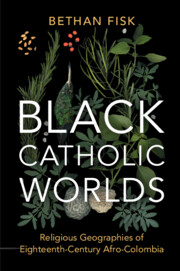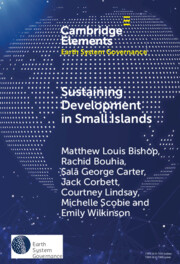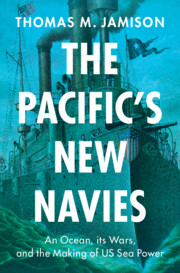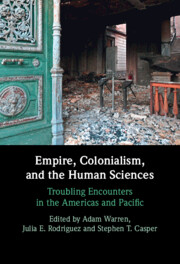Refine search
Actions for selected content:
98 results
4 - Spiritual Pasture in the Pacific
- from Part II - Religion in Place
-
- Book:
- Black Catholic Worlds
- Published online:
- 28 August 2025
- Print publication:
- 11 September 2025, pp 162-204
-
- Chapter
- Export citation

Black Catholic Worlds
- Religious Geographies of Eighteenth-Century Afro-Colombia
-
- Published online:
- 28 August 2025
- Print publication:
- 11 September 2025
Iron status of Māori, Pacific and other infants in Aotearoa New Zealand
-
- Journal:
- Proceedings of the Nutrition Society / Volume 84 / Issue OCE2 / June 2025
- Published online by Cambridge University Press:
- 24 July 2025, E161
-
- Article
-
- You have access
- Export citation
Disputes at port, disputes at sea: how fishing rights and practices shaped Taiwan-Pacific relations from the 1950s to the 1980s
-
- Journal:
- Journal of Global History , First View
- Published online by Cambridge University Press:
- 15 July 2025, pp. 1-16
-
- Article
-
- You have access
- Open access
- HTML
- Export citation
Facing Extinction: Can the Pacific Bluefin Tuna be Saved?
-
- Journal:
- Asia-Pacific Journal / Volume 14 / Issue 15 / August 2016
- Published online by Cambridge University Press:
- 14 March 2025, e10
-
- Article
-
- You have access
- Open access
- Export citation
“Quite Unimportant”: Franco-Australian Settler Antagonism in the New Hebrides and British Imperial Policy in the Southwest Pacific, 1870-1906
-
- Journal:
- Asia-Pacific Journal / Volume 15 / Issue 9 / April 2017
- Published online by Cambridge University Press:
- 14 March 2025, e4
-
- Article
-
- You have access
- Open access
- Export citation

Sustaining Development in Small Islands
- Climate Change, Geopolitical Security, and the Permissive Liberal Order
-
- Published online:
- 30 January 2025
- Print publication:
- 30 January 2025
-
- Element
-
- You have access
- Open access
- HTML
- Export citation
Chapter 17 - Rethinking Critical Geographies
-
-
- Book:
- The New Nineteenth-Century American Literary Studies
- Published online:
- 02 January 2025
- Print publication:
- 23 January 2025, pp 249-264
-
- Chapter
- Export citation
5 - The Californian Case for a New Navy
-
- Book:
- The Pacific's New Navies
- Published online:
- 05 December 2024
- Print publication:
- 12 December 2024, pp 104-126
-
- Chapter
- Export citation
Conclusion
-
- Book:
- The Pacific's New Navies
- Published online:
- 05 December 2024
- Print publication:
- 12 December 2024, pp 175-184
-
- Chapter
- Export citation
Introduction
-
- Book:
- The Pacific's New Navies
- Published online:
- 05 December 2024
- Print publication:
- 12 December 2024, pp 1-15
-
- Chapter
- Export citation

The Pacific's New Navies
- An Ocean, its Wars, and the Making of US Sea Power
-
- Published online:
- 05 December 2024
- Print publication:
- 12 December 2024
8 - War and the State in the Pacific
- from Part III - Case Studies
-
- Book:
- Bringing War Back In
- Published online:
- 14 November 2024
- Print publication:
- 21 November 2024, pp 185-222
-
- Chapter
- Export citation

Empire, Colonialism, and the Human Sciences
- Troubling Encounters in the Americas and Pacific
-
- Published online:
- 24 October 2024
- Print publication:
- 07 November 2024
-
- Book
-
- You have access
- Open access
- Export citation
Chapter 10 - Conclusion
-
- Book:
- Assault Brigade
- Published online:
- 25 October 2024
- Print publication:
- 12 August 2024, pp 203-217
-
- Chapter
- Export citation
A Method for the Quantitative Estimation of Clay Minerals in North Pacific Deep-Sea Sediments
-
- Journal:
- Clays and Clay Minerals / Volume 27 / Issue 3 / June 1979
- Published online by Cambridge University Press:
- 01 July 2024, pp. 175-184
-
- Article
- Export citation
Chapter 18 - The Impact of Community-Based Participatory DOHaD Research
- from Section 4 - Translations in Policy and Practice
-
-
- Book:
- The Handbook of DOHaD and Society
- Published online:
- 20 June 2024
- Print publication:
- 27 June 2024, pp 207-218
-
- Chapter
-
- You have access
- Open access
- HTML
- Export citation
37 - Queer Beginnings at the End of the Frontier
- from Space and the Regional Imaginary of Queer Literature
-
-
- Book:
- The Cambridge History of Queer American Literature
- Published online:
- 17 May 2024
- Print publication:
- 06 June 2024, pp 672-684
-
- Chapter
- Export citation
13 - South-West Pacific
-
-
- Book:
- Australia in World Affairs 1971–1975
- Published online:
- 29 March 2024, pp 324-346
-
- Chapter
- Export citation
VI - Australia and Asia
-
- Book:
- Australia in World Affairs 1950–1955
- Published online:
- 29 March 2024, pp 200-242
-
- Chapter
- Export citation
